Contemporary art has always been a powerful medium for expressing ideas and pushing boundaries. In recent years, there has been a resurgence of interest in the art form of folding screens. These versatile objects, traditionally used as room dividers, are now being reimagined by contemporary artists as a means of exploring themes of representation, femininity, and the intersection of physical and digital spaces. In this article, we will delve into the fascinating world of folding screens in contemporary art, examining the works of renowned artists and the impact they have on the art world.
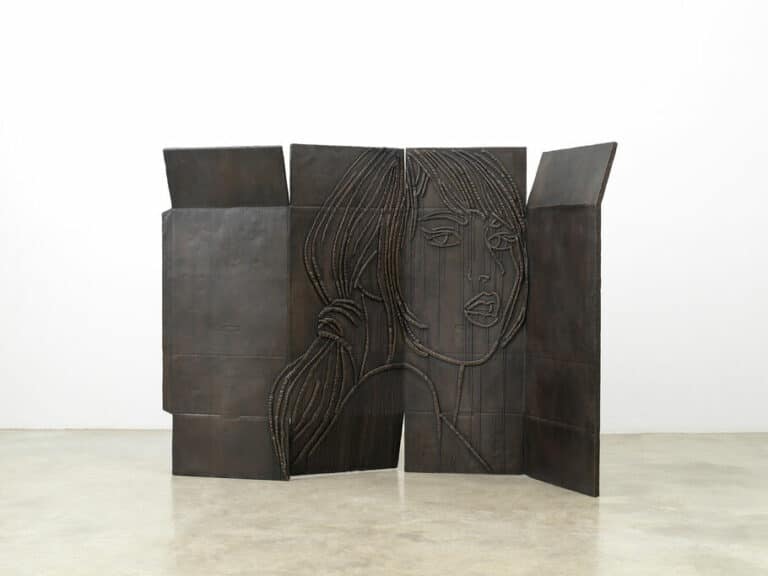
Folding screens have a rich history that spans centuries and cultures. Originating in China during the Zhou dynasty, these screens were initially used for contemplation and as objects of beauty. Over time, they spread to other parts of Asia, including Japan and Korea, where they became an integral part of traditional interior design.
In the 17th to 21st centuries, folding screens evolved to become elaborate works of art, often adorned with intricate paintings, calligraphy, or decorative motifs. These screens served multiple purposes, from providing privacy and dividing spaces to showcasing the wealth and power of their owners. However, it is only recently that contemporary artists have started to explore the potential of folding screens as a medium for their artistic expression.
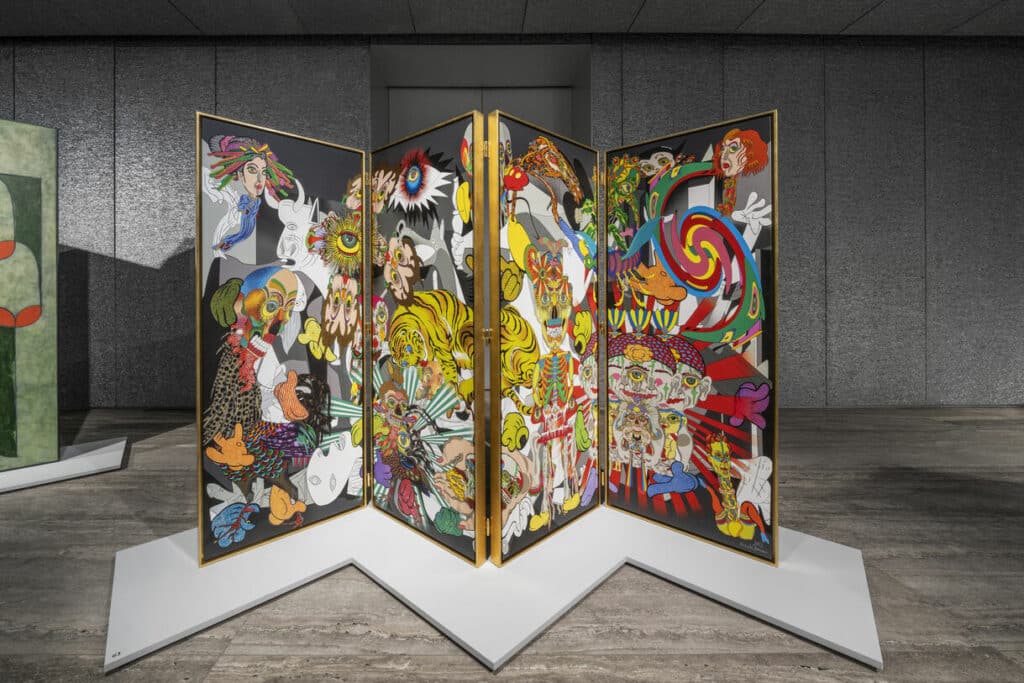
Many of the historical examples in the show depict grand military narratives, evoking might and authority. “They become an ostentatious display of wealth, or power,” said Cullinan. But for a number of contemporary artists, part of the fascination of folding screens is their dual function of hiding and revealing: While obscuring the space behind them, they draw attention to their own subject matter.
Many artists in the show play on the tension created by that duality, using screens to highlight subjects that are usually hidden. Lisa Brice’s Untitled (2022), for instance, depicts, over five hinged screens, a series of anonymized nude women smoking, drinking, and admiring themselves. One, standing astride a mirror, is painting her own version of L’Origine du Monde, Gustave Courbet’s famous 1866 picture of a vulva. Here, Brice revels in putting on display what women are supposed to hide: their creativity and self-assuredness. The folding screen’s conventional purpose of providing cover and preserving modesty is thereby subverted.
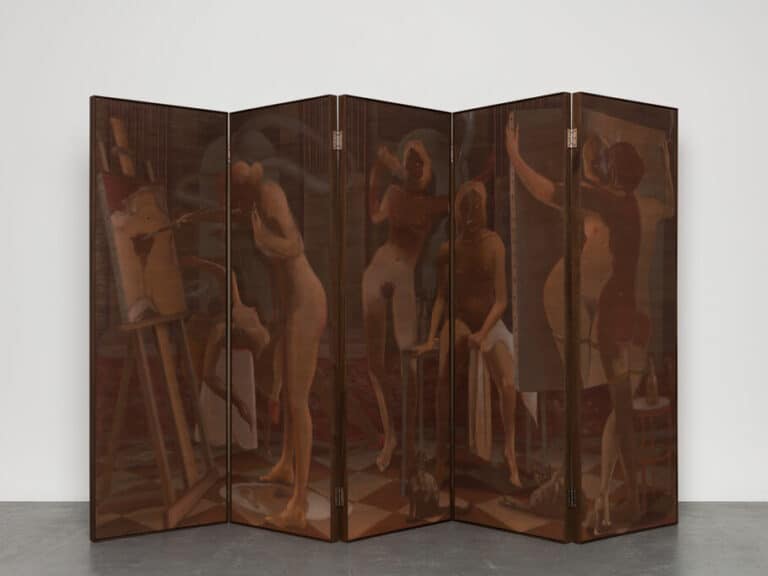
Lisa Brice, Untitled, 2022. © the artist. Photo by Mark Blower. Courtesy the artist, LGDR and Rennie Collection.
One of the key reasons why folding screens have captivated contemporary artists is the duality of their function. While screens traditionally serve to hide or divide spaces, artists today are more interested in the dividing aspect rather than the hiding aspect. They use folding screens as a canvas to explore themes of visibility, representation, and the hidden aspects of our society.
Ghada Amer, a prominent contemporary artist, showcases this exploration in her exhibition titled “Paravent Girls.” Although she initially did not intend to create folding screens for the show, she ended up casting bronze screens from flattened cardboard boxes. Amer’s screens feature bold sketches of young women, many of which are appropriated from porn magazines. By placing these “girls” on the screens, Amer challenges the conventional notion of hiding and reveals the power of division inherent in folding screens.
The artistic renaissance of folding screens is not limited to Ghada Amer. Artists around the world are using this medium to express their unique perspectives and challenge societal norms. Lisa Brice, for example, subverts the conventional purpose of folding screens in her work “Untitled.” Through a series of hinged screens, she depicts anonymized nude women smoking, drinking, and embracing their creativity. Brice’s work celebrates what women are often encouraged to hide, bringing their self-assuredness and creative expression to the forefront.
Carrie Mae Weems, another influential artist, explores the historical dynamics of portraying and concealing nude women in her piece “The Apple of Adam’s Eye.” This bright orange three-panel screen features a female figure covered in blue cloth, surrounded by Gothic-style gold text. Weems directly addresses the idea of female temptation and challenges the traditional narratives associated with women’s bodies.
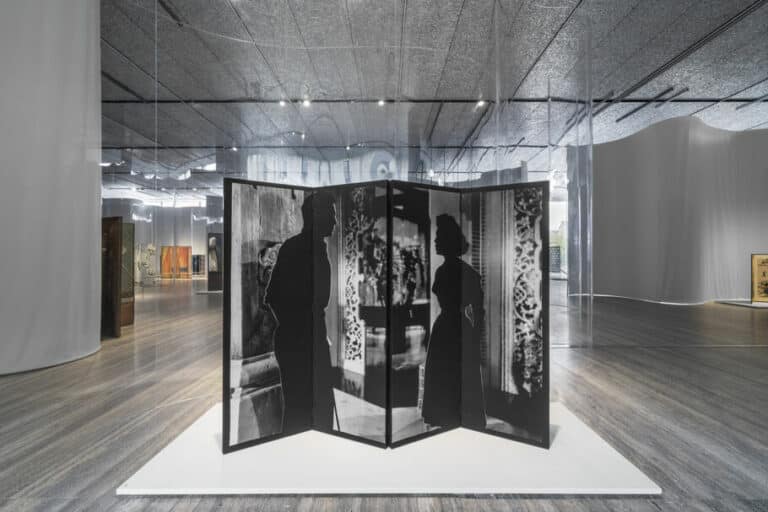
John Stezaker, Screen-screen, 2023, in “Paraventi: Folding Screens from the 17th to 21st Centuries” Fondazione Prada, Milan. Photo by Delfino Sisto Legnani and Alessandro Saletta – DSL Studio. Courtesy of Fondazione Prada.
The gender politics of visibility play a significant role in the exploration of folding screens in contemporary art. Historically, folding screens have been seen as decorative or domestic objects, often marginalized due to their gendered associations. However, contemporary artists are reclaiming this medium and using it to highlight narratives that are often overlooked.
Polish artist Małgorzata Mirga-Tas, for instance, collages recycled textiles on folding screens to represent women from her local Roma community. By using folding screens, Mirga-Tas allows viewers to see both sides of the object, creating a dual pictorial space that connects different time periods and individuals. Her work challenges the historical persecution of the Roma community and brings their stories to the forefront.
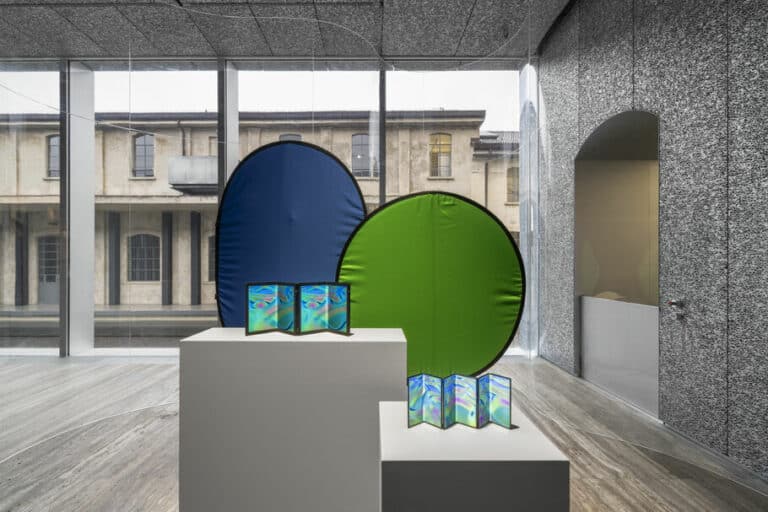
In our increasingly digital world, folding screens have taken on a new significance. Many contemporary artists are exploring the parallels between folding screens and digital or film screens, blurring the boundaries between physical and virtual realities. Artists like John Stezaker and Cao Fei are incorporating digital elements into their folding screen installations, creating thought-provoking works that question the nature of screens and their impact on our perception of reality.
John Stezaker’s work “Screen-screen” presents a black-and-white image of shadowy figures on a classic paravent. The title of the piece invites us to consider the overlapping functions of domestic folding screens and movie projections. Does a folding screen put itself on display? Does a movie projection hide something? Stezaker’s work challenges our understanding of screens and their role in shaping our experiences.
Cao Fei takes this exploration further with her installation “Screen Autobiography (Milan).” Using folding electronic devices and collapsible green screens, Fei examines the blurring of reality in the images we consume on our devices. By manipulating photos and videos and inserting digitally rendered backgrounds, Fei questions the authenticity of our digital experiences and the impact they have on our perception of the world.
The artistic renaissance of folding screens has not gone unnoticed by the art world. Institutions like Fondazione Prada have curated exhibitions that bridge the gap between historical folding screens and contemporary interpretations of the medium. These exhibitions showcase the diverse range of artists working with folding screens and highlight the significance of this art form in the context of contemporary art.
Nicholas Cullinan, the curator of Fondazione Prada’s three-venue exhibition, emphasizes the importance of covering the historical and contemporary aspects of folding screens in a single show. By juxtaposing historical examples with contemporary works, these exhibitions create a dialogue between the past and the present, shedding new light on the potential of folding screens as a medium for artistic expression.
The artistic renaissance of folding screens in contemporary art is a testament to the power of this versatile medium. Contemporary artists are using folding screens to challenge societal norms, explore themes of visibility and representation, and blur the boundaries between physical and digital spaces. Through their innovative and thought-provoking works, they are reshaping our understanding of folding screens and their potential as a medium for artistic expression. As the interest in folding screens continues to grow, we can expect to see even more groundbreaking and boundary-pushing works in the years to come.
Header image: Ghada Amer, installation view of “Paravent Girls” at Tina Kim Gallery, 2023. Photo by Charles Roussel.Courtesy of Tina Kim Gallery.
Island Magazine is a hybrid platform for contemporary art in the form of an online magazine, career advice services for artists, and an online gallery program.